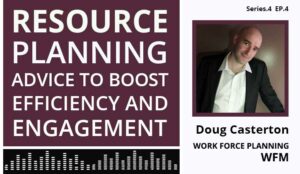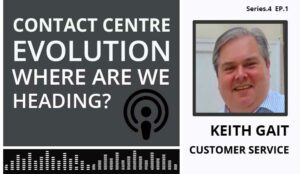The Contact Centre Podcast: Series 4 Episode 4
Doug Casterton, a Senior WFM Manager, shares some key pieces of advice, learned through great experience, in how to increase resource planning efficiency and employee engagement.

In our conversation, we also talk about boosting forecast accuracy, designing shift patterns and the personal qualities that make up a really great contact centre planner.
To listen to the podcast directly from this web page, just hit the play button below:
The Contact Centre Podcast – Episode 22:
Resource Planning Advice To Boost Efficiency And Engagement
This podcast was made possible by our sponsor NICE.
Podcast Time Stamps
1:52 – Forecasting Tips
5:22 – Forecast Metrics
7:23 – Scheduling to Increase Engagement
11:40 – Lifestyle Scheduling
15:28 – Intraday Management
19:45 – What Makes a Good Planner?
Here is a Transcript to the Podcast
Charlie Mitchell: One common best practice for resource planning that I’ve heard is not just create one single forecast, but an upper, middle, and low-level forecast, too. So just before we get into some of the more complex stuff about a WFM, what do we mean by upper, middle, and low-level forecasts, and how can they help to boost a contact centre’s efficiency?
Doug Casterton: Sure. I think what you’re talking about here is prediction bands, which are primarily used to represent an uncertainty or confidence in a forecast. We typically, in my experience, use them in workforce management to look at just how confident you are and also to express that to stakeholders and to make decisions. So I always start with the premise that the first rule of forecasting is that all forecasting is either wrong or lucky. It’s just to what extent is it likely to be wrong? Things like, for example, the size or the volume unit that you’re forecasting, the individual randomness associated to that particular forecast, and the number of event drivers associates at fault, all have an impact.
Doug: Event drivers being, for example, something like, say, an email drop that might generate a propensity to contact. Something as simple as a known email drop is much more likely to be accurate than, say, a customer service-type contact that only occurs as a result of some sort of failure demand. And these all generate uncertainty. Prediction bands are really helpful because they not only paint the story around how confident you are, they then narrow the band, the more confident you are. But they also help to inform the decision-makers on what will happen if worst-case or best-case scenario is to happen.
Charlie: I think that’s really interesting, especially that first rule of forecasting is that all forecasting is wrong is—
Doug:It’s the one I usually bring in almost every forecasting conversation is just remember, we don’t have a crystal ball. There’s some beliefs I think, with certain stakeholders that will absolutely believe, they’ll pin all their hopes on that one number. The reality is it could be a range of different situations, and when you paint that, that helps them to understand that they perhaps shouldn’t be pinpointing on one particular decision. It’s a variable of different outcomes that could occur.
Charlie: I think it’s really illuminating as well in the fact that maybe we should also be experimenting with different types of forecasting methods. Not just the one that we’re used to, as well as creating different levels for our forecasts. Is that something that you’d definitely advocate?
Doug: Just because you’ve had some success with one particular model, or statistical model, or method of forecasting, that doesn’t necessarily mean that that particular method or model will be the one that you want to use in the future. I think this is actually quite a common flaw for forecasters. They hit upon a method, they see that it’s providing the accuracy they want, and then they never change it until suddenly something goes completely wrong.
Some of these more sophisticated forecasting tools are automated, they go through continuous model-fit situations. So they’re constantly looking at, does this model that we have used in the past still fit, and is it still best to use that one? Or is there something that’s now becoming better to use as a result of changing environments or added features in there that weren’t factored in before. So yes is the answer, absolutely. You should be constantly looking that your method’s still fit for purpose.
Charlie:I think it’s a very interesting, I wouldn’t say flaw, but it’s a very common mistake that a lot of contact centres make. And I think another one that I’ve definitely heard you speak about before is to improve efficiency in forecasting, a mistake is to be 100% focused on getting 100% forecast accuracy. And I know you like to use a simple process called forecast value-added (FVA). What would this involve?
Doug: Traditional forecasting performance metrics like, for example, MAPE (mean absolute percentage error), They’ll tell you the size of the forecast error, but they won’t tell you anything about how efficient you are forecasting. Both as your manual inputs but also the methods that you’re using, so whether your efforts are making that forecast better or worse. This is where I think FVA can add a lot of value, it can be really helpful. It’s also really simple to understand so you can use it basically expressing the results of doing something extra in your forecasts versus doing nothing.
It’s a bit like… a good comparison would be how a drug trial is conducted, where they’re using a placebo to benchmark against the results of the drug trial. Only instead of using that placebo, you’re using a comparison against what we’d refer to as a naive forecast. A naive forecast can be basically any method, although it’s recommended you keep it really simple and it’s your line in the sand. So it’s whenever you’re making an improvement to your forecast, you measure against that naive forecast.
So that you can see, for example, if in the case of, say, we’ve got a new product launch or we’re changing the types of products. Do I add that or do I not add that into my forecasts? And you can look at historically the results of accuracy versus the naive forecast that never includes these things, just how much value that’s adding. And you often will find situations where that extra two or three hours that you’re spending adding in that complicated step in your forecasting process is really only adding marginal value. Therefore, is it worth it? And it really helps you to define where you put your efforts to improve your forecast.
Charlie: I think there’s so much great stuff in there. It’s almost like a benchmarking system for your forecasts. I think that’s really great, and there’s so much more that we could talk about when it comes to forecasting. But I just want to quickly move on to scheduling. And one thing that I’ve really noticed since I’ve been in the contact centre industry is that many contact centre planners treat scheduling almost as if it’s a game of Tetris, instead of an opportunity for employee engagement. Is this something that you’ve also seen, and why is this maybe not the best approach?
Doug: I like that Tetris analogy, I see that a lot. And not only that, but that whole button-pushing type of mentality that often comes with using a WFM system but not really thinking about the wider human elements of what you’re doing. I think it’s remarkably easy to look at all the elements of an operation, customers even as numbers. However, you can almost go so far as to say that in developing an employee strategy, numbers shouldn’t even be your primary focus. I’ve long believed that great customer experience starts actually with great employee engagement. And in a previous organization, they really focused on having everything they do at the heart of the employee. Because they knew that if an employee was really engaged, they would also be providing great customer experience.
Doug: And that really comes true when it comes to how workforce management can complement it. It’s not just in the scheduling strategy but also across many of the different things or outcomes that workforce management provides. I like this visualization. If you could imagine a triangle with three major elements that workforce management should be focusing on, in each one of the corners or vertices you have cost, customer, employee. When you’re focusing just on schedule efficiency, that analogy you’ve run around Tetris, you’re really probably just focusing on customer and cost but you’re forgetting completely around the employee.
Doug: And the problem with doing that is that this then ultimately probably will impact your customer outcomes and your cost outcomes. When, for example, engagement drops, customer experience also drops, resulting in more failure demand being driven into your contact centre. And then purely directly with the employee side of things, you’re losing potentially efficiency as a result of people now perhaps being more absent and ultimately leaving the company, and the cost and customer impact that comes with higher turnover in contact centres. So it’s absolutely vital to focus on the triangle rather than on one component of, say, cost or customer.
Charlie:That’s a really interesting example, having that triangle. And if you push too far in a direction in either way of that triangle, something’s going to fall apart. And I think that’s a really great image. And as you say, the downside of treating scheduling like Tetris is that it’s humans that you’re playing the Tetris with, and people don’t often live their lives in blocks of time that are a perfect fit for an efficient contact centre schedule. And that’s where the schedule satisfaction comes in. But how do you think we can change our organizational mindset so that we and WFM can get the support to really make employee engagement a big part of our WFM strategy?
Doug: Stop measuring this end to end. For example, on engagement surveys, these type of things, start talking about the impact the workforce management or scheduling practice is having. And measuring it so you can call a rate, for example, on a change in scheduling practice to engagement changes, or absence, or attrition. We know these things are definitely connected, but we don’t do enough work, I think, to actually measure it analytically. But the data’s there.
Doug: So once you start to paint the picture of this type of scheduling practice and engagement, it results in reduced absence and attrition. And you can put it back to that ultimate figure that most businesses will be caring about, hopefully, which is cost. It starts to become really real. But it’s connecting the dots that probably workforce management don’t do enough of because we go directly to the costs bit, without thinking about the human considerations that influence costs and customer.
Charlie:I think that’s a really good point. I’m really fixating quite a lot on this idea that resource planning is a really big opportunity for employee engagement, because I think it’s something we’re seeing more and more. Should we maybe be designing shifts to better suit people’s lifestyles, or at least adding value to those less desirable shift patterns?
Doug: In my experience, I guess from doing this for nearly 17 years, I constantly come across the most common applied scheduling practice being what’s referred to as quality scheduling. This is a type of practice that assumes that by treating everyone the same we’re treating everyone fair, even when considering the fact that each employee will have a different life outside of work. Lifestyle scheduling, for me, is about treating everyone as an individual. It’s equity scheduling versus that equality that I mentioned earlier. Appreciation that each individual preference matters and that every preference is likely to be different from individual to individual.
Doug: Often you’ll see, for example, practices that are applied across the board, say for parents. But who’s to say that one individual preference, say that I’m a really keen golfer, is less important than somebody that has another individual preference. And I think this is where lifestyle scheduling can really add value, both ticking off the optimization benefit, because you can design your individual schedules to match your business needs. But you can also tailor in the preferences of the individual rather than, like I say, this equality-type approach that usually ends up making the majority of people unhappy. And only the minority, which probably didn’t care that much in the first place, not that much difference in opinion.
Charlie: I think that’s very interesting. You’re talking a lot about the individual needs, and I think this also has a big significance for your recruitment strategy as well. Because I knew a planner once who targeted social care professions when recruiting for a night shift. When he did that, he achieved a 0% attrition rate because they were used to that lifestyle and they had the necessary social skills that would make really good contact centre advisors. I think having ideas like that, it’s a very interesting topic, but again, there’s so much that we could cover. Just quickly on the—
Doug: I’ll just give probably one more thing on it. There’s two things that you do need to consider if you’re going down the lifestyle route. Don’t go totally down it because if you do, you can potentially run into some problems later down the line. For example, if you have completely individual schedules, one, it’s hard to maintain. And secondly, that if you ever get into a situation where you’re not back-filling your attrition, you could potentially create gaps in your schedule cover. Look at it holistically and have strategies to fill different needs.
The second observation that I’d make is that by asking your people what they would like to work, you’ll often find people out there that have lifestyles that have decided to work…They’re actually wanting to work what is typically classed as the unpopular shifts. A prime example is students. They often will be quite happy to work on the weekends and the evenings, because they’re in class during the daytime. And this then helps you to tailor your approach, perhaps reducing the number of unsociable or unpopular shift patterns for the majority of people. It’s another added value of a lifestyle, and it’s worth engaging your people to really find out they are willing and want to work. You’d be surprised by the results.
Charlie: It’s very interesting because when I went into a contact centre recently, they were asking advisors who all worked a fixed shift of five days a week, and they gave them loads of options for which shift they would most like. Most of them said a four-day week, but working the same hours as they would the 37.5 hours. Just getting in search of what your employees actually want is a very interesting thing. But quickly now, moving on. I think it’s very important that we talk a little bit about intra-day management as well, which is a very important part of a resource planner’s job. Or on-the-spot resource planning, as some people say. So what pieces of advice would you give somebody in terms of boosting efficiency when the contact centre gets really busy?
Doug: Personally, I’m always slightly cautious about short-term tactics that will boost efficiency, because they can sometimes do more harm in the long run. For example, when you push people on a particular tactic. For example, one might be that you realign your routing so that you’re putting the types of contacts that you know that certain segments of your population are quicker on. However, the long-term harm of doing that would be that, whilst they become and continue to be proficient, nobody else learns. So you isolate segments of your learning within your population of contact centre.
In fact, I’ve even found some counter-type tactics, like giving extra breaks, that sounds really counterproductive, but after a prolonged period of time of really being busy, this can help boost efficiency. Despite the fact that in the short term it’s actually taking away. The best advice that I can give to any real-time team is really to plan and engage ahead of time so that instead of seeking live solutions in the moment, you’re enacting solutions that are pre-agreed.
Time and time again, I’ve come across real-time teams that are really good at reacting in the moment. But they’re having to spend a huge amount of their time and resource seeking permission to do those actions or to engage and understand what they should be doing in this moment. If you can outline a set of protocols that the real-time team and the operation will use as a checklist for real-time and operation action or ensuring that you’re following the pre-agreed actions. And then also have clear and concise messages to maintain that consistent approach, raise awareness of those agreed remedial actions. But more importantly, also ensuring that everybody’s really clear on what their role or responsibility is.
This type of initiative, for me, is the one that really creates that next level for real-time and it builds confidence and removes surprises. Which I think the two pieces of feedback that I’ll get from every business that I’ve worked in from stakeholders is, how do we feel confident that the real-time team are actually doing something? And secondly, what are they doing? So if you’ve got that pre-agreed and communicated upfront, there is no surprises and there is no ambiguity around what the real-time team are doing. And your speed of action is quicker because you don’t have to seek permission.
Charlie: I think it’s a really good point to get this, I’ve heard them described as standard operating procedures, in place.
I think that your point, especially around making sure everybody knows what their role is within that was very critical, as well. And this was actually a question that I asked to John Casey, who I know you know well, in a previous podcast. One thing that he really advised doing alongside that was avoiding knee-jerk decisions. Do you think this is a key skill for any WFM manager?
Doug: Yes, across the whole piece. Actually, in an emergency situation, sometimes the worst thing you can do is knee-jerk. So there’ll be a lot of pressure on, say, the real-time team to just do something, but in reality that could do more harm than good. The first point and case that I made. Sometimes with these short-term tactical benefits, by the time you’ve enacted them, one, the incident is over, and two, you’ve ended up doing more harm than good. Less knee-jerk, more pre-thought is, for me, the way to go.
Charlie: I think that’s a very interesting point because a good lesson to everyone that a good plan, they will always take their time and step back and understand what has happened to their plan. Particularly even after the real-time has happened. Do you think this ability to look back after a real-time situation and think to yourself, what could I have done differently to improve efficiency and engagement within my schedule? Do you think that the best quality in their planner is that desire to keep learning and keep improving their resource plans?
Doug: I’m often asked what do I look for when I’m hiring somebody in workforce planning or in real-time? And I think technical skills can be taught, but the behaviours and traits of an individual are much harder to learn. So I always look for somebody that has tenacity because I think this can be a tough job, but more importantly, curiosity. Continual learning is driven by somebody’s curiosity.
You can say and build a development plan and you can send somebody on a course, but if they’re not curious, the likelihood is one, they won’t absorb much of it. And two, they won’t apply it. Curiosity drives learning. It also drives to look into particular datasets or situations that are occurring and explore them deeper. And without that trait for me, you’re always up against driving somebody to become better at their job. For me, curiosity is the thing that drives all the right traits when it comes to a really good analyst.
Charlie: I think that’s a really nice point again. The final question has just come to my mind. Last week I was at a CCMA event, and I was at a table of resource planners and contact centres. And they were telling me that one of the biggest problems that they have is that staff don’t understand the impact that being just a little bit late, or just having one extra day off, can have on the entire contact centre schedule. And I know there’s a rule within WFM called the power of one. I don’t know if you could just quickly explain this to everybody and maybe suggest a great way to teach the power of one rule within the contact centre?
Doug: I’m not sure I’ve got great ways of… when you hear about one normal tactic, but yes, the power of one has been around probably as long as contact centres, but it’s not always embedded in the culture. The idea is very simple, that your actions as an individual can have major impacts on the customer, ultimately, in how long they queue. When you think it’s just one minute but you multiply it, say across the population of say 1,000 agents. That if every single person is taking just that one minute, that’s a hell of a lot of amount of time that’s being taken away from serving the customer.
So how do you get that across when somebody is, for example, “Oh, it’s just one minute”? This is where you can have some sort of fun exercises, and they’ve evolved over time. Mainly because health and safety have come in and said, “Some of these exercises are not particularly good for the welfare of our agents.” I had a prime example of one where we were lifting an agent up with a mat, and we would take one person away until finally the person fell to the floor. Because when they hurt their back that was considered not particularly a wise move going forward.
More recently, I’ve used balloons. We had, say, 10 agents in a room and 10 balloons. Their job is just to juggle that one balloon at a time, and then you slowly take that one person away. And you can see then the impacts of how difficult it is, even just with one person coming out, how many balloons are dropped. Each of these balloons, then, is representing a lost customer interaction. Even, by the way, I had some problems with health and safety on the balloons. We’ll find something, but the concept is really to demonstrate just how much power one person or a collection of people moving in the same direction can have, at the same time. And that the manager of workforce planning has to ensure that we’ve got the right number of people, at the right time, with the right skill. And the power of one is the operation side of how they play into that in order to deliver that to plan.
Charlie: I think that’s a really good message to end on. Maybe not the mat example. Definitely, we’ll have some jump off of that boat.
Doug: Yes, I stopped myself on that one, I wouldn’t recommend it.
Charlie: I think the balloon one was really great and I think it’s really a great way to end this podcast. And as we’ve discussed lots of different areas but lots of really great points that we’ve talked about. Just one quick final thing, question for you is, just where can our listeners go to hear more from you?
Doug: I have a blog that I’ve been doing for the last eight years, which I think is a good way to schedule, because it’s the WFManagement.com. And I also posted a lot on LinkedIn as well. I’m really always very happy to connect to individuals that have an interest in workforce management on LinkedIn. Happy to answer questions directly. And lastly, we also have a telegram group, which is a community-driven group for workforce management professionals. Now close to 800 people in there, with constant back-and-forward questions, and you’ll find me contributing to that group a lot as well.
Charlie: Excellent stuff. I think also on your LinkedIn, just to give it a quick little plug, you used to, if you go back through Doug’s activity, you’d find 100 really great tips for WFM that you’ve done before, which we took onto Call Centre Helper as well. We stole them with your permission.
Doug: You took it to another level. I love how you interlinked other parts and content that you had. I thought that was really neat. I’d definitely recommend that for all your readers and listeners.
Charlie: So there’s 100 tips and it’s nearly all Doug’s insight and it’s really great stuff. Anyway, for now, thank you for joining us today, Doug. Lots of great topics discussed.
Doug: Thank you very much.
Author: Charlie Mitchell
Published On: 27th Apr 2020 - Last modified: 26th Sep 2025
Read more about - Podcasts, Charlie Mitchell, Doug Casterton, NiCE, Podcast






































